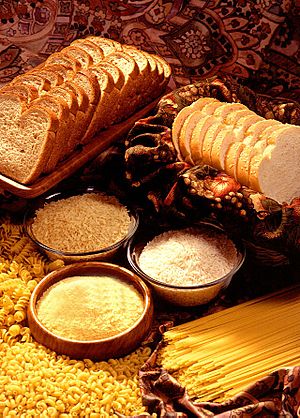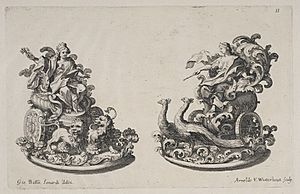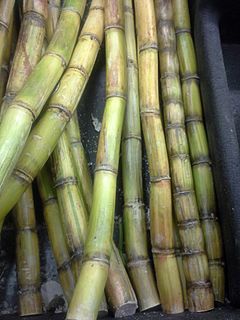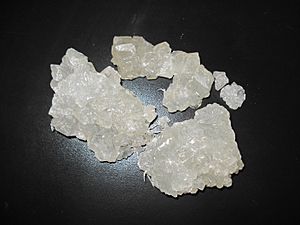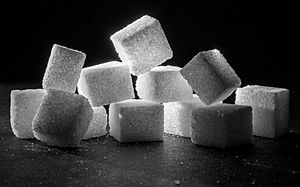Sugar facts for kids
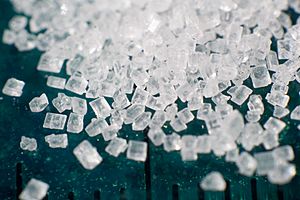
Sugar is a common name for many sweet-tasting chemical substances. Most often, when people say "sugar," they mean sucrose, lactose, or fructose. Sugar is found naturally in some foods, or it can be added to make things taste sweet. We get sugar from plants like sugarcane and sugar beet.
The sugar you usually add to food is called sucrose. Fructose is the sugar found in fruits. Both sucrose and fructose are made from even smaller sugar parts. Glucose is one of these common smaller sugars. Your body changes regular sugar into these smaller sugar parts when you eat it.
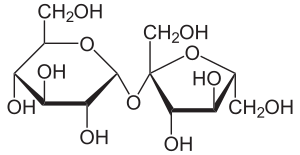
Sugars are a type of carbohydrate. This is because they are made of carbon, hydrogen, and oxygen. Carbohydrates can be either simple or complex. Simple carbohydrates have only one or a few small sugar units. Complex carbohydrates are made of many small sugar units linked together.
Starch is a complex carbohydrate found in foods like bread, crackers, and potatoes. It's made from many glucose molecules. When you eat starch, your body breaks it down into smaller sugars. Pure starch doesn't have a taste in your mouth.
Brazil produces the most sugar per person. India uses the most sugar overall as a country.
There are other things that taste sweet but are not sugar. For example, Stevia comes from a plant. Others, like aspartame, are made in factories. These are generally called artificial sweeteners or sugar substitutes. People use them to avoid some health problems linked to too much sugar.
Sugar can come in different colors. For instance, brown sugar has molasses in it. It's often used in baking.
Contents
A Sweet History: How Sugar Became Popular
Sugar's Journey from Ancient Times
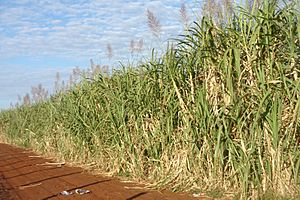
Sugar has been made in India for a very long time. From there, it spread to other places. In ancient times, sugar was not common or cheap. Most people used honey to sweeten their food. At first, people just chewed raw sugarcane to get its sweetness. Sugarcane grew naturally in tropical parts of India and Southeast Asia.
Different types of sugarcane came from different places. Some came from India, and others from New Guinea. One of the earliest records of sugarcane is from Chinese writings around 800 BCE. They say that sugarcane use started in India.
Indians also found out how to turn sugarcane juice into hard crystals. These crystals were easier to store and move around. This discovery happened around 500 CE. These crystals were called khanda in India, which is where our word candy comes from! Indian sailors helped spread the knowledge of sugar along their trade routes. Buddhist monks also took sugar-making methods to China.
Sugar Comes to Europe
The ancient Greeks and Romans knew about sugar. A Greek doctor in the 1st century CE described sugar in his medical book. A Roman writer, Pliny the Elder, also wrote about it. He said, "Sugar is made in Arabia as well, but Indian sugar is better. It is a kind of honey found in cane, white as gum, and it crunches between the teeth."
Crusaders brought sugar back to Europe after their journeys to the Holy Land. There, they saw traders with "sweet salt." By the 12th century, the city of Venice started making sugar to sell in Europe. Sugar slowly began to replace honey as the main sweetener.
In the 15th century, sugar started to become much more available. This happened when sugarcane was grown on islands like Madeira and the Canary Islands. By 1492, Madeira was making over three million pounds of sugar each year! Sugar was still expensive, but people developed a "passion for sugar."
Sugar was also thought to have "valuable medical properties." People believed it was good for the stomach and could help with cold illnesses.
Sugar sculptures became popular at big feasts. These were amazing artworks made entirely of sugar. At first, people ate them, but later they became just decorations.
Sugar's Modern Story
In 1492, Christopher Columbus brought sugarcane cuttings to the New World. The first sugarcane harvest in Hispaniola happened in 1501. By the 1520s, many sugar mills were built in Cuba and Jamaica. The Portuguese also took sugarcane to Brazil.
Sugar was a luxury in Europe until the 1700s. Then, it became more common and by the 1800s, people saw it as a necessity. This huge demand for sugar caused big economic and social changes. It led to the colonization of tropical islands where sugarcane could be grown. The need for cheap labor to work on these plantations led to a terrible increase in the slave trade from Africa.
After slavery ended, many workers for the sugar plantations came from India. Millions of people were moved around the world because of the demand for sugar. This is why many nations today have a mix of different ethnic groups.
Sugar also led to some industrial growth. For example, sugar factories were built in India in the late 1700s.
During the Napoleonic Wars, it was hard to get sugar from overseas. So, Europe started growing more sugar beets to make sugar. By 1880, sugar beet was the main source of sugar in Europe.
Until the late 1800s, sugar was sold in large cone shapes called loaves. People had to cut off pieces using special tools. Later, granulated sugar was sold in bags. Sugar cubes were invented in the 1800s by Jakub Kryštof Rad in Moravia.
Sugar was rationed (limited) during World War I and World War II. This led to the creation and use of artificial sweeteners.
How Sugar is Made
Making Sugar from Sugarcane
| Sugarcane Production – 2016 | |
|---|---|
| Country | (millions of tonnes) |
| 768.7 | |
| 348.4 | |
| 122.7 | |
| 87.5 | |
| World | 1890.7 |
| Source: FAOSTAT, United Nations | |
In 2016, the world produced about 1.9 billion tonnes of sugarcane. Brazil made 41% of this, and India made 18%.
Sugarcane is a tall grass that grows in warm, tropical places. People have grown it for centuries to get the sweet sucrose from its stems. In the 1700s, sugarcane farms grew very big in the Americas. The use of slavery made sugar cheap enough for many people to buy. Today, machines do some of the work, but growing and making sugar still needs many workers.
Sugarcane needs a warm climate with enough rain. Workers harvest the crop, either by hand or with machines. The cut cane goes quickly to a sugar mill. There, the juice is squeezed out. This juice is cleaned and heated. Then, the water is removed, and the syrup becomes very thick. Sugar crystals form and are then dried. Molasses is a leftover product, and the plant fibers (called bagasse) are burned to power the mill.
Making Sugar from Sugar Beet
| Sugar Beet Production – 2016 | |
|---|---|
| Country | (millions of tonnes) |
| 51.4 | |
| 33.8 | |
| 33.5 | |
| 25.5 | |
| 19.5 | |
| World | 277.2 |
| Source: FAOSTAT, United Nations | |
In 2016, the world produced 277 million tonnes of sugar beets. Russia grew 19% of this total.
The sugar beet became a major source of sugar in the 1800s. This happened when people found ways to get sugar from it. The sugar beet is a plant with a large root that holds a lot of sucrose. It grows in cooler areas with good rainfall and rich soil. The roots are harvested in the autumn.
At the processing plant, the beets are washed and sliced. The sugar is then pulled out using water. The juice is cleaned, and water is boiled away. The thick syrup is cooled, and sugar crystals form. These white sugar crystals are then separated and dried. This sugar is ready to use without more cleaning.
Refining Sugar for Purity
Refined sugar is made from raw sugar that has been cleaned to remove molasses. Raw sugar comes from either sugarcane or sugar beet. While you can eat raw sugar, refining makes it taste better and look whiter.
Often, raw sugar is shipped to another country for refining. The first step is to wash the raw sugar crystals in a thick syrup. This softens and removes the sticky brown coating. The crystals are then separated and dissolved in water. This syrup is cleaned again to remove more impurities.
Next, the color is removed, often using special carbon or resins. The sugar syrup is boiled until it's very thick, then cooled. Sugar crystals form again. These white crystals are spun in a machine to remove any leftover liquid. Finally, the crystals are dried with hot air and are ready to be packaged.
The International Commission for Uniform Methods of Sugar Analysis sets rules for how pure refined sugar should be. Lower numbers mean the sugar is purer. Refined sugar is used a lot in factories because it's very pure.
Different Kinds and Uses of Sugar
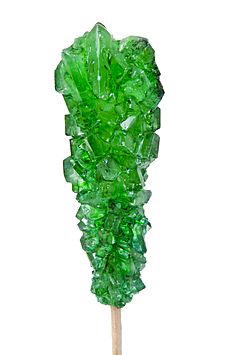
Sugar Crystal Sizes
- Rock candy (or misri) refers to large sugar crystals. It started in India and Iran. People use it as a candy or to sweeten drinks like milk or tea.
- In Western countries, these are known as rock candy or rock sugar. Food coloring can be added to make them colorful.
- Coarse-grain sugar, also called sanding sugar, has large, shiny crystals (about 1 to 3 mm). It's used on top of baked goods and candies because it doesn't melt easily.
- Granulated sugar (about 0.6 mm crystals) is also called table sugar or regular sugar. This is the sugar you use at home for drinks, baking, and desserts. It's also used to preserve foods like jams.
- Milled sugars are ground into a fine powder. They are used for dusting foods and in baking.
- Caster sugar is very fine, like superfine sugar in the U.S. (about 0.35 mm).
- Powdered sugar, also called confectioner's sugar or icing sugar, is even finer. It comes in different levels of fineness.
- Snow powder is a type of powdered sugar that doesn't melt, often made of glucose.
- Screened sugars are sorted by crystal size. They are used for decorating or in dry mixes.
Sugar Shapes
- Sugar cubes (or sugar lumps) are white or brown granulated sugar pressed into block shapes. They are used to sweeten drinks.
- Sugarloaf was the cone shape that refined sugar was sold in until the late 1800s. This shape is still used in some countries today.
Brown Sugars
Brown sugars are granulated sugars that either still have some molasses in them, or have molasses added to them. This gives them their light or dark brown color. They are used in baked goods and candies. The more molasses they have, the darker they are. Examples include:
- Light brown sugar, with a small amount of molasses (about 3.5%).
- Dark brown sugar, with more molasses (about 6.5%).
- Non-centrifugal cane sugar is unrefined and very dark. It's made by just boiling down sugarcane juice. Examples are Panela and some types of muscovado and jaggery.
Liquid Sugars
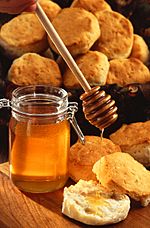
- Honey is a thick, sweet liquid made by bees from flower nectar. It mainly contains fructose and glucose.
- Syrups are thick liquids made mostly of sugar dissolved in water. They are used in many foods like drinks, candies, and jams.
- Simple syrup is sugar dissolved in water (often 50% sugar, 50% water).
- Syrups can also be made by boiling down natural juices, like maple syrup from maple sap.
- Corn syrup is made from corn starch.
- High-fructose corn syrup (HFCS) is made by changing some of the glucose in corn syrup into fructose.
- Inverted sugar syrup is a mix of glucose and fructose. It's made by heating sugar in water. It helps keep baked goods moist and prevents sugar from crystallizing.
- Molasses and treacle are left over after sugar is removed from sugarcane or sugar beet juice. They can be added to other syrups to make them sweeter. They are used in baked goods and candies.
- Blackstrap molasses is very dark with a strong flavor and less sugar. It's sometimes used in animal feed or to make rum.
- Regular molasses and golden syrup are lighter in color and have more sugar.
Other Sweeteners
- Low-calorie sweeteners often mix maltodextrin with other sweeteners. Maltodextrin is made from starch.
- Polyols are sugar alcohols used in things like chewing gum. They give a long-lasting sweet taste.
- Many different artificial sweeteners with zero calories are also used as sugar substitutes.
How Much Sugar We Eat
In most parts of the world, sugar is a big part of what people eat. It makes food taste good and gives us food energy. After grains and vegetable oils, sugar from sugarcane and beet provides more calories per person each day than other food groups. In 2016, people in the United States, Germany, and the Netherlands ate the most sugar per person.
Related pages
Images for kids
-
Still-Life with Bread and Confectionery, by Georg Flegel, first half of 17th century
See also
 In Spanish: Azúcar para niños
In Spanish: Azúcar para niños


